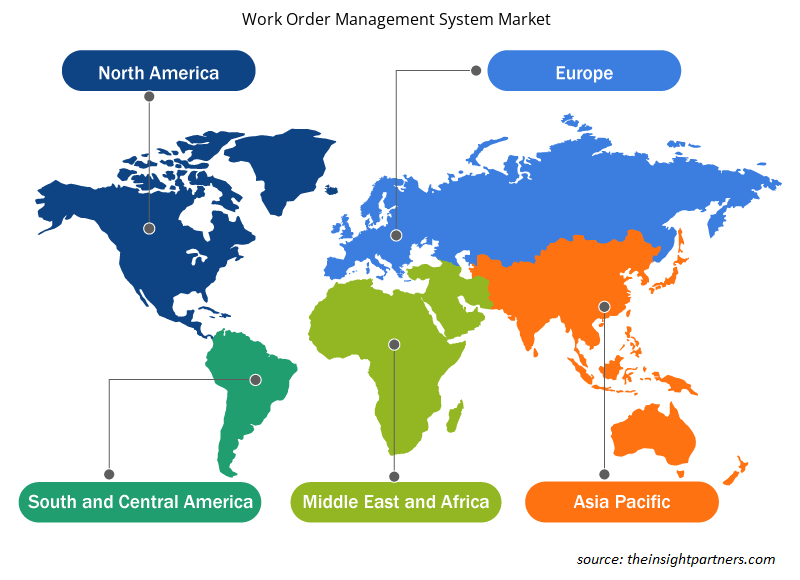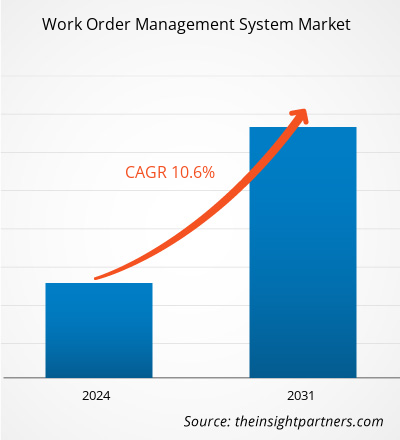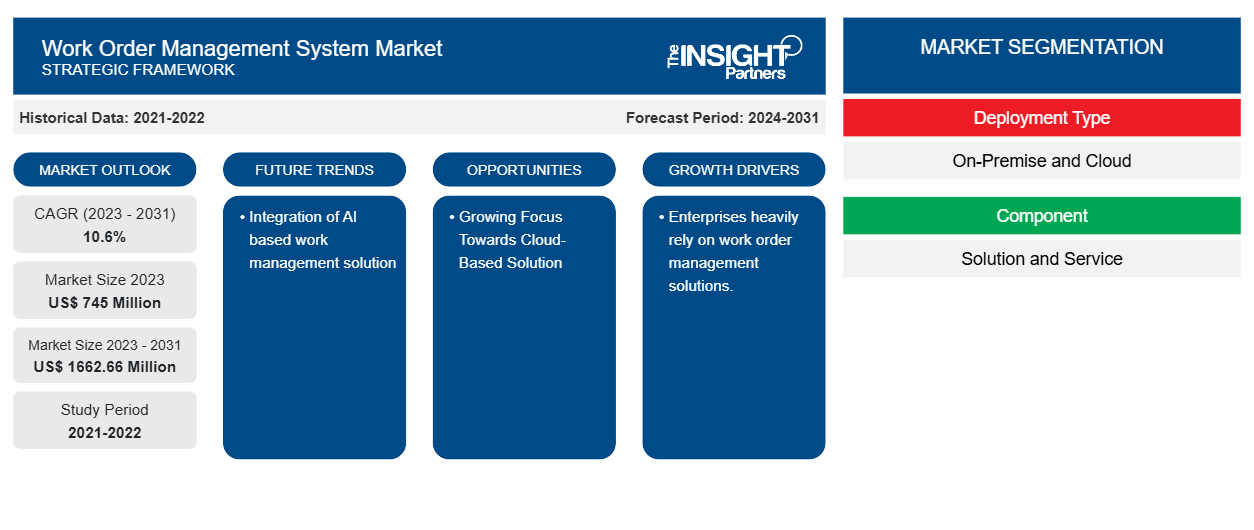작업 주문 관리 시스템 시장 규모는 2023년 7억 4,500만 달러에서 2031년까지 1,662.66백만 달러에 도달할 것으로 예상됩니다. 작업 주문 관리 시스템 시장은 2023~2031년 동안 10.6%의 CAGR을 기록할 것으로 예상됩니다. 기업은 점진적으로 디지털 혁신을 향해 나아가고 있으며 다양한 기술을 구현하여 장비 유지 관리 및 산업 운영을 관리하고 있습니다.
작업 주문 관리 시스템 시장 분석
관리형 작업 주문에 대한 수요 증가와 개선된 프로젝트 실행은 시장을 주도하는 몇 가지 요인입니다. 기업이 주문을 관리하고 중앙에서 추적해야 하는 필요성이 증가하고 클라우드 기반 작업 주문 관리 시스템을 채택하는 것이 증가함에 따라 작업 주문 관리 시장 성장이 촉진되고 있습니다. 그러나 작업 주문 관리 시스템을 기존 관리 시스템에 통합하는 데 따른 복잡성, 데이터 보안과 관련된 문제, 경험이 풍부한 근로자의 제한된 가용성은 작업 주문 관리 시스템 시장 성장을 방해하는 몇 가지 요인입니다. 또한 새로운 기술을 작업 주문 관리 시스템에 통합하면 이러한 문제를 극복하고 시장을 주도하는 데 도움이 될 수 있습니다.
작업 주문 관리 시스템 시장 개요
작업 주문 관리(Work order management)는 자재 관리, 인바운드 물류, 재고 관리, 장비 관리 및 유지 관리, 제조 생산 라인, 품질 관리, 운송 및 스테이징에 필수적입니다. 다양한 산업에서 기존의 기록 관리 기술은 효과가 없습니다. 지난 몇 년 동안 원자재 조달에서 완제품 판매에 이르기까지 전반적인 제조 공정은 수작업에 크게 의존하여 수많은 오류가 발생하여 운영 효율성이 떨어졌습니다. 따라서 제조 회사는 운영을 최적화하기 위해 자동화된 절차를 통합하고 있습니다. 제조 회사는 고객 마감일을 맞추고 시장에 남기 위해 경쟁력 있는 물류 및 운영을 갖춰야 하며, 이는 작업 주문 관리 시스템을 통해 달성할 수 있습니다.
귀하의 요구 사항에 맞게 이 보고서를 사용자 정의하세요
이 보고서의 일부 또는 국가 수준 분석, Excel 데이터 팩을 포함하여 모든 보고서에 대한 사용자 정의를 무료로 받을 수 있으며 신생 기업 및 대학을 위한 훌륭한 혜택과 할인 혜택을 이용할 수 있습니다.
- 이 보고서의 주요 시장 동향을 알아보세요.이 무료 샘플에는 시장 동향부터 추정 및 예측까지 다양한 데이터 분석이 포함됩니다.
작업 주문 관리 시스템 시장 동인 및 기회
기업 간 작업 주문 관리 솔루션에 대한 의존도 증가
작업 주문 관리 시스템은 제조, 에너지 및 유틸리티, 소비재 및 소매, 의료 및 생명 과학, BFSI, 운송 및 물류, 소매 및 건설, 통신 및 IT, 기타(정부, 미디어 및 엔터테인먼트)와 같은 주요 산업 분야의 기업에서 현장 인력 활용도를 높이기 위해 빠르게 채택되고 있습니다. 또한 효율적인 작업 주문 관리 시스템은 기업에서 관리되는 작업 주문과 원활한 프로젝트 실행에 대한 증가하는 요구를 충족합니다. 클라우드 기반 솔루션을 포함한 작업 주문 관리 솔루션을 채택하면 조직에서 중앙에서 주문을 관리하고 추적할 수 있습니다. 따라서 기업에서 작업 주문 관리 솔루션에 대한 의존도가 높아지면서 시장이 성장합니다.
클라우드 기반 작업 주문 관리 솔루션 채택 증가
최종 사용자는 자산 관리 및 원활한 공급망 운영을 위해 웹 호스팅 솔루션 및 모바일 애플리케이션과 같은 클라우드 기반 작업 주문 관리 시스템을 점점 더 많이 채택하고 있습니다 . 또한 IoT 및 AI와 작업 주문 관리 시스템의 통합이 증가하고 현장 근로자에게 정보 흐름을 개선하는 데 중점을 두면서 예측 기간 동안 작업 주문 관리 시스템 시장에 대한 여러 가지 잠재적 전망이 창출될 것입니다.
작업 주문 관리 시스템 시장 보고서 세분화 분석
작업 주문 관리 시스템 시장 분석에서 도출된 주요 세그먼트는 배포 유형, 구성 요소, 최종 사용자 산업입니다.
- 작업 주문 관리 시스템 시장은 배포 유형에 따라 온프레미스와 클라우드로 구분됩니다.
- 구성 요소별로 시장은 솔루션과 서비스로 나뉩니다.
- 작업 주문 관리 시스템 시장은 최종 사용자 산업을 기준으로 IT 및 통신, 제조, BFSI, 의료, 소매 및 운송으로 구분됩니다.
지역별 작업 주문 관리 시스템 시장 점유율 분석
작업 지시 관리 시스템 시장 보고서의 지리적 범위는 주로 북미, 아시아 태평양, 유럽, 중동 및 아프리카, 남미 및 중미의 5개 지역으로 나뉩니다. IoT 기술은 제조업, 특히 미국과 같은 선진국에서 인력 부족을 극복하는 데 유용한 리소스입니다. 미국의 연방 정부와 민간 부문 조직은 국가의 산업 기반을 개발하는 데 도움이 되는 Industry 4.0 IoT 기술에 투자하고 있습니다. AI, IoT, 3D 인쇄 및 기타 스마트 기술은 이미 국가의 대형 제조업체의 성과 지표를 개선하고 있습니다. 또한 북미의 다양한 국가 정부는 로봇 시장에서 새로운 기술 개발을 촉진하기 위한 다양한 프로그램을 출시하여 로봇 도입을 장려하고 있습니다. 따라서 다양한 운영에서 첨단 기술을 구현하면 작업 지시 관리 시스템 시장의 성장을 지원합니다.
작업 주문 관리 시스템 시장 지역 통찰력
Insight Partners의 분석가들은 예측 기간 동안 작업 주문 관리 시스템 시장에 영향을 미치는 지역적 추세와 요인을 철저히 설명했습니다. 이 섹션에서는 북미, 유럽, 아시아 태평양, 중동 및 아프리카, 남미 및 중미의 작업 주문 관리 시스템 시장 세그먼트와 지리적 분포도 논의합니다.

- 작업 주문 관리 시스템 시장을 위한 지역별 특정 데이터 얻기
작업 주문 관리 시스템 시장 보고서 범위
| 보고서 속성 | 세부 |
|---|---|
| 2023년 시장 규모 | 7억 4,500만 달러 |
| 2031년까지 시장 규모 | 16억 6,266만 달러 |
| 글로벌 CAGR (2023-2031) | 10.6% |
| 역사적 데이터 | 2021-2022 |
| 예측 기간 | 2024-2031 |
| 다루는 세그먼트 | 배포 유형별
|
| 포함된 지역 및 국가 | 북아메리카
|
| 시장 선도 기업 및 주요 회사 프로필 |
|
작업 주문 관리 시스템 시장 참여자 밀도: 비즈니스 역학에 미치는 영향 이해
작업 주문 관리 시스템 시장은 소비자 선호도의 변화, 기술 발전, 제품의 이점에 대한 인식 증가와 같은 요인으로 인해 최종 사용자 수요가 증가함에 따라 빠르게 성장하고 있습니다. 수요가 증가함에 따라 기업은 제품을 확장하고, 소비자의 요구를 충족하기 위해 혁신하고, 새로운 트렌드를 활용하여 시장 성장을 더욱 촉진하고 있습니다.
시장 참여자 밀도는 특정 시장이나 산업 내에서 운영되는 회사나 기업의 분포를 말합니다. 주어진 시장 공간에 얼마나 많은 경쟁자(시장 참여자)가 존재하는지 그 규모나 전체 시장 가치에 비해 나타냅니다.
작업 주문 관리 시스템 시장에서 운영되는 주요 회사는 다음과 같습니다.
- 아스테아 인터내셔널 주식회사
- 인포 주식회사
- 마이크로소프트 주식회사
- IBM 주식회사
- 신탁
- 히포 CMMS
면책 조항 : 위에 나열된 회사는 어떤 특별한 순서에 따라 순위가 매겨지지 않았습니다.

- 작업 주문 관리 시스템 시장 주요 주요 업체 개요를 알아보세요
작업 주문 관리 시스템 시장 뉴스 및 최근 개발
작업 주문 관리 시스템 시장은 1차 및 2차 연구 이후의 질적, 양적 데이터를 수집하여 평가되며, 여기에는 중요한 기업 간행물, 협회 데이터 및 데이터베이스가 포함됩니다. 작업 주문 관리 시스템 시장의 몇 가지 개발 사항은 다음과 같습니다.
- Gooten은 주문형 생산을 위해 특별히 고안된 주문 관리 플랫폼인 OrderMeshTM을 출시했습니다. 이 플랫폼은 리테일러, 제조업체, 전자상거래 브랜드 및 마켓플레이스가 제품 옵션을 확장하고, 주문 처리를 간소화하고, 주문형 공급망의 운영 복잡성과 비용을 크게 최소화하도록 돕기 위해 고안되었습니다. (출처: Gooten, 보도자료, 2024년 2월)
- 영국의 소프트웨어 회사인 Everfield는 텔레콤, 유틸리티, 인프라 부문에 초점을 맞춘 작업 주문 관리 소프트웨어 공급업체인 Depotnet을 인수했습니다. 이 인수를 통해 Depotnet은 Everfield의 지원과 리소스의 혜택을 누리면서 확장과 혁신에 참여할 수 있게 되었습니다. (출처: Everfield, 보도자료, 2023년 9월)
작업 주문 관리 시스템 시장 보고서 범위 및 제공물
"작업 주문 관리 시스템 시장 규모 및 예측(2021-2031)" 보고서는 아래 영역을 포괄하는 시장에 대한 자세한 분석을 제공합니다.
- 범위에 포함된 모든 주요 시장 세그먼트에 대한 글로벌, 지역 및 국가 수준의 작업 주문 관리 시스템 시장 규모 및 예측
- 작업 주문 관리 시스템 시장 동향 및 운전자, 제한 장치 및 주요 기회와 같은 시장 역학
- 자세한 PEST/포터의 5가지 힘 및 SWOT 분석
- 주요 시장 동향, 글로벌 및 지역 프레임워크, 주요 업체, 규정 및 최근 시장 개발 사항을 포괄하는 작업 주문 관리 시스템 시장 분석
- 시장 집중도, 히트맵 분석, 유명 업체 및 작업 주문 관리 시스템 시장의 최근 개발 사항을 포함하는 산업 환경 및 경쟁 분석
- 자세한 회사 프로필
- 과거 분석(2년), 기준 연도, CAGR을 포함한 예측(7년)
- PEST 및 SWOT 분석
- 시장 규모 가치/거래량 - 글로벌, 지역, 국가
- 산업 및 경쟁 환경
- Excel 데이터세트
최근 보고서
관련 보고서
사용 후기
구매 이유
- 정보에 기반한 의사 결정
- 시장 역학 이해
- 경쟁 분석
- 고객 인사이트
- 시장 예측
- 위험 완화
- 전략 기획
- 투자 타당성 분석
- 신흥 시장 파악
- 마케팅 전략 강화
- 운영 효율성 향상
- 규제 동향에 발맞춰 대응





















 무료 샘플 받기 - 작업 주문 관리 시스템 시장
무료 샘플 받기 - 작업 주문 관리 시스템 시장